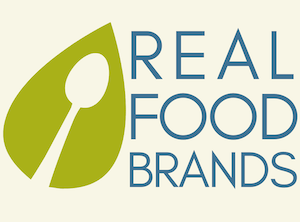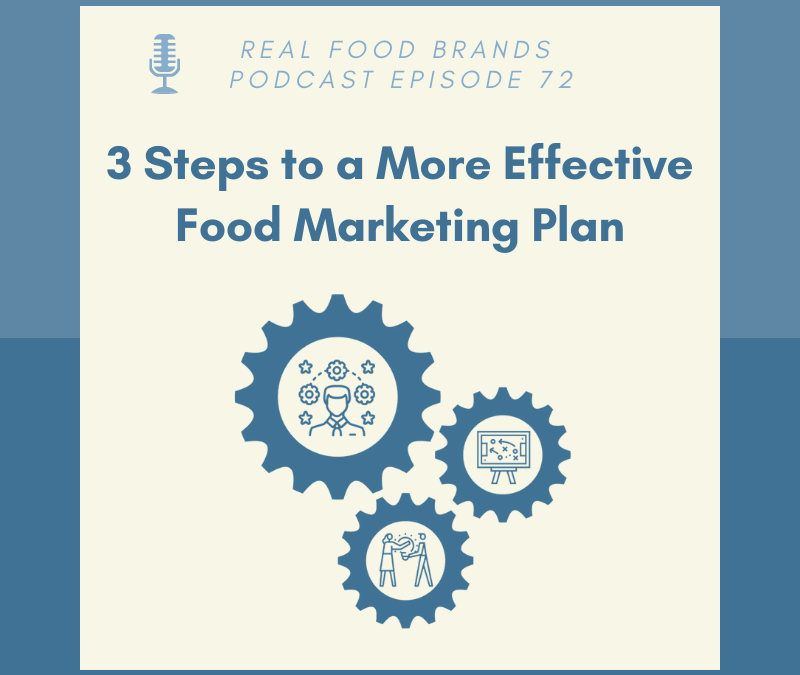When it comes to Marketing Planning, Katie likes to say that 1+1=3. In other words, when all of your tactics are working together based on your marketing strategy, the whole is greater than the sum of its parts.
This week on the Real Food Brands Marketing Podcast, host and Food & Bev Brand Strategist Katie Mleziva shares a three step process for marketing planning to help you better create your plan to align with your business objectives, then allocate resources to make it happen!
1. Create Your Strategic Marketing Plan
Before we ever start talking about marketing tactics we need to think about our overall business objectives. After all, the reason we think about marketing our products in the first place is to achieve our business objectives, right?! Start with the 2-4 objectives you have this year for your food business. They could be revenue or profit targets, or even a social impact goal. The important thing is to write them down, so you can keep them top of mind and track against them. From that list, you then create high-level marketing goals that support those overall business goals. Katie lists examples of marketing goals in the episode so you know the difference between business objectives and marketing goals.
Another important piece of creating a strategic marketing plan for your food business is to think about your ideal core consumer and identify the primary marketing challenge, or what your marketing efforts need to accomplish. Who are you working to engage and what matters to them? When it comes to the marketing challenge in front of you, there’s some reason people aren’t buying your product as much or as often as they could be, so spend some time thinking about the key attitude, belief, or behavior you could change to get people to take action. Having your ideal consumer definition in place helps you get specific about what, specifically for this audience, will make this transformation happen.
The important thing to note is that the marketing strategies and tactics are identified only after you think through these more strategic pieces to the plan to make sure every one of your marketing efforts ladders back up to your overall business objectives.
Tactics are the tools you use to put your strategic marketing plan into action: email marketing, social media channels, blog content, coupons, free samples, trade shows (when we do those again), collaborations with influencers, the list goes on. Write down as many ideas as you can think of that makes sense for your particular food business, and then make a decision about which tactics will best help you hit your goals.
Many businesses start executing tactics without laying the strategic foundation first, but that often leads to haphazard social media posts and random emails that aren’t engaging your audience as much as you’d like. Once you know what each of your tactics is working together to achieve, it’s easier to prioritize them and implement them.
2. Turn It into a Tactical Marketing Plan
Once you have ideas that will support your marketing strategies, plot them out on a calendar. Start with the things you have less control over, like holidays, category reviews at retailers you plan to pitch, new product launches, etc. Katie suggests using a tool like Trello, Excel, or Google Sheets to create a year-long plan, with the focus being on the next 3 months. Getting everything plotted out can help make sure your messaging is aligned and your tactics are working together to achieve your objectives.
You can always revisit these throughout the year to see what’s working and where you might need to change your approach. Identify the KPIs (Key Performance Indicators) that will help you keep track of what’s working and what’s not, and put everything into a calendar to keep track of important dates.
3. Make It Happen: Do, Build, Buy
Now that you have a plan, it’s time to put it into action. Katie shares three main ways to make it happen: Do, Build, and Buy. You can do it yourself between you or your team, you can build the capability within your business (courses, coaches, tools, etc), or you can buy the capacity or capabilities, meaning hire someone to do it for you. It may also be a combination of these things.
Now that you have your plan framed out in detail in a way that helps every tactical action support your overall business objectives, you’re better equipped to make those decisions and keep track of whether they’re working together to meet your business objectives, and when it’s time to pivot.
Now, let’s go shake up shopping carts!
In This Episode:
- Three steps to create an integrated Marketing Plan for your food business, including the step most people miss.
- Why you need to start with your business objectives before you think about marketing tactics.
- How to turn business objectives into marketing goals.
- Why knowing your ideal core consumer is critical to your marketing plan.
- How the right marketing tactics and messages will be more clear when using this method of marketing planning.
- Why you need to use KPIs to keep track of what’s working and what’s not, so you can adjust your marketing plans, if needed, to reach your business goals before it’s too late.
Quotes:
“The whole is greater than the sum of its parts when all your tactics are working together based on your strategy, and you’ve got the right people working on the right things.” – Katie Mleziva
“If you’ve been listening or have worked with me, you know I’m a big fan of actually writing things down. Having your goals in writing where you can see them puts them that much closer within reach…and I mean it puts them in reach both literally and figuratively!” – Katie Mleziva
“Remember: Every strategy and tactic should ladder back up to helping the ideal audience overcome the marketing challenge so you can achieve your marketing goals and ultimately your business objectives.” – Katie Mleziva
Resources:


